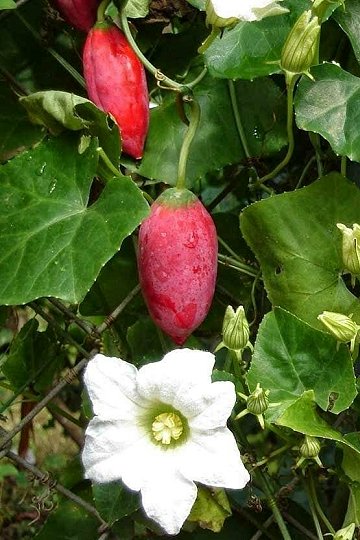
|
|
Tindola - Ivy gourd
(Coccinia grandis).Flowers and fruits.
|
Tindola - Ivy gourd - Coccinia grandis
The scarlet gourds are a genus (Coccinia from the Greek, kokkinia or kokkinias - "red" or "scarlet") with 25 species. It is distributed in sub-Saharan Africa and with one species, C. grandis also in South and South-east Asia, and it is also introduced into the New World. Incidentally, C. grandis is also a cultivated crop and it is used for culinary and medical purposes.
All species occur in sub-Saharan Africa, from semi-arid savannas to rain forests, rarely also mountain forests. The species adapted to these different habitats one to several times independently. [1] One species, C. grandis also occurs in tropical Asia, but is also spreading to Australia, several Pacific Islands and the tropical Americas. Sometimes it behaves invasive, e.g. in Hawaii, where it is regarded as obnoxious weed.
Coccinia grandis, the ivy gourd, also known as scarlet gourd, tindora and kowai
fruit, is a tropical vine. Ivy gourd is a perennial climbing plant producing stems up to 20 metres long from a tuberous rootstock. It clambers over other plants, supporting itself by means of tendrils. Young stems are annual and herbaceous, but can become perennial and woody with time.
The leaves are glabrous, usually stalked, rarely sessile.
The leaves have 5 lobes and are 6.5–8.5 cm long and 7–8 cm wide, usually with teeth along the margin. The lower leaf side often bears small nectar-producing glands.
The species is dioecious. Female and male flowers emerge at the axils on the petiole, and have 3
stamens.
The fruit is up to 5cm long. The smooth and thin-skinned fruit turns red when fully ripe, It is egg shaped, up to 6cm long and 3.5cm wide.
The plant is occasionally cultivated for its edible fruit and also its medicinal uses in tropical and sub-tropical zones, especially in India, Malaysia and
Indonesia. The plant is sold in local markets, and is also sometimes exported to speciality
markets. There are some named varieties.
The fruits of Coccinia grandis can be eaten raw or cooked.
The rRipe scarlet fruits are eaten raw. They are
fleshy and sweet. The pulp of fully ripe fruits is creamy with an agreeable slightly acid flavour.
Young and tender green fruits are eaten raw in salads or cooked and added to curries etc. Young leaves and shoots are also edible. All used plants are a good source of carotenoids. The tuber of Coccinia abyssinica is cooked and a source of starch for the Oromo people in Ethiopia. Local culinary uses also exist. However, many species and also populations within species can be bitter due to cucurbitacins.
Ivy gourd with Onion pickle curry made in a house in Vijayawada, Andhra Pradesh, India.
They are best when cooked, and are often compared to bitter melon. The fruit is commonly eaten in Indian cuisine. People of Indonesia and other Southeast Asian countries also consume the fruit and leaves. In Thai cuisine, it is one of the ingredients of the very popular clear soup dish kaeng jued tum
lueng and some curries kaeng khae curry and kaeng lieng curry. In India, it is eaten as a curry, by deep-frying it along with spices, stuffing it with masala and sauteing it, or boiling it first in a pressure cooker and then frying it. It is also used in sambar, a vegetable and lentil-based soup. The immature fruit is also used raw, preserving its crisp texture, to make a quick fresh pickle.
Coccinia grandis is also well known in ayurvedic medicine for diabetes treatment, and modern research seems to confirm that it might be of value in that application.
In traditional medicine, fruits have been used to treat leprosy, fever, asthma, bronchitis, and jaundice. The fruit possesses mast cell-stabilizing, antianaphylactic, and antihistaminic
potential. In Bangladesh, the roots are used to treat osteoarthritis and joint pain. A paste made of leaves is applied to the skin to treat
scabies.
Ivy gourd extracts and other forms of the plant can be purchased online and in health food stores. These products are claimed to help regulate blood sugar levels. Some research supports that compounds in the plant inhibit
glucose-6-phosphatase. Glucose-6-phosphatase is one of the key liver enzymes involved in regulating sugar metabolism. Therefore, ivy gourd is sometimes recommended for diabetic patients. Although these claims have not been supported, a fair amount of research on the medicinal properties of this plant are focusing on its use as an antioxidant, antihypoglycemic agent, immune system modulator, etc.[citation needed] Some countries in Asia, such as Thailand, prepare traditional tonic-like drinks for medicinal purposes.
Source:
https://en.wikipedia.org/wiki/Coccinia
https://en.wikipedia.org/wiki/Coccinia_grandis
http://tropical.theferns.info/viewtropical.php?id=Coccinia+grandis
